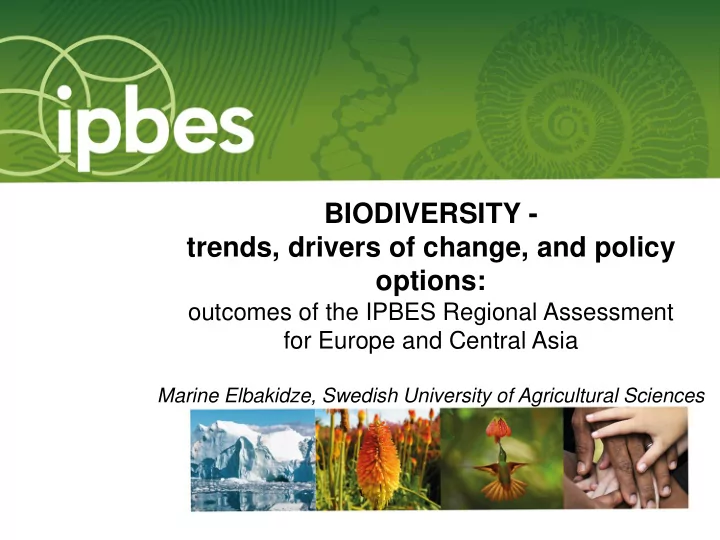

BIODIVERSITY - trends, drivers of change, and policy options: outcomes of the IPBES Regional Assessment for Europe and Central Asia Marine Elbakidze, Swedish University of Agricultural Sciences
Setting th the scene ➢ Biodiversity continues dangerous decline ➢ Biodiversity is key to human wellbeing ➢ The decline is due to multiple interacting drivers, which undermine efforts to achieve the Aichi Targets and the SDGs ➢ We need more and better scientific information ➢ IPBES regional assessment
Europe and Central l Asia ia 56 countries 40 – members of IPBES Western Europe (WE) Eastern Europe (EE) Central Europe (CE) Central Asia (CA)
Biodiversity: Marine/freshwater habitats and species ▪ The abundance, range and habitat size of many marine species is shrinking: - 48% of marine animal and plant species have been declining in the last decade ▪ Freshwater species and inland surface water habitats are particularly threatened across ECA - 75% of catchment areas in ECA are heavily modified - 37% of freshwater fish and 23% of amphibians are currently threatened with extinction in CE and EE
Biodiversity: Terrestrial species ▪ Terrestrial species and habitats have long-term declining trends in population size, range, habitat intactness and functioning: - 42% of terrestrial animal and plant species have been declined in population size - 75% of local bird breeds and 58% of local mammal breeds are threatened with extinction.
Past (1950-2000) and current (2001-2017) trends
Trends in nature’s contributions to people
II. II. Bio iodiv iversity: Driv iver of f change
Land use change: Forestry Trend 1: Increasing intensity of management on forested land: ➢ increasing extraction of bioenergy resources ➢ increasing area of forest plantations ➢ intensification of forest management Trend 2: Continuous logging of intact forest landscapes ➢ Russia is among three countries that comprise 52% of the total reduction of intact forest landscapes Effects on biodiversity and NCP: Loss of structural components; Simplified spatial structure; Simplification of natural processes; Fragmentation of forest habitats
Land use change: Agric icult lture Intensification of conventional agriculture: ➢ Large-scale monocultures ➢ High level of agrochemical inputs ➢ Irrigation ➢ High level of mechanization ➢ Genetically modified crops
Land use change: Agric icult lture Effects of conventional agriculture intensification: ➢ Transformation and modification of natural and semi-natural habitats physically, biologically and chemically ➢ Reductions in species richness and diversity of plants, wild bees and birds ➢ Introduction of genetically modified crops ➢ Erosion of natural capital (e.g. pollinators, natural enemies of pest, soil biodiversity)
Oth ther driv ivers of f change in in bio iodiv iversity ▪ Extraction of abiotic and biotic resources: - Overfishing - Extraction of mineral resources (e.g., CA and EE) ▪ Pollution: - Have decreased across the ECA, but due to time-lag effects and organic pollution/pesticides - still threaten biodiversity ▪ Invasive alien species: - Have increased for all taxonomic groups
Im Impact of f in indirect drivers on dir irect drivers
Biodiversity: Policy options THREE major directions: 1. Mainstreaming the conservation and sustainable use of biodiversity and the sustained provision of NCPs into policies, plans, programmes, strategies and practices of public and private actors: - Raising awareness of the dependence of good quality of life on nature - Defining policy objectives concerning all sustainability dimensions - Designing policy instruments and policy mix to support policy implementation
Biodiversity: Policy options 2. Developing integrated approaches across sectors : - Coordination between sectors and sustainable management practices within each sector - Measure national welfare beyond current economic indicators, taking into account of the diversity values of nature - Introduction of ecological fiscal reforms
Biodiversity: Policy options 3. Participation of a wide range actors and stakeholders in governance process: - Development of public-private partnership, co- management arrangements or even private governance involving many stakeholders - Increasing funding from both public and private sources, together with innovative financial mechanism (e.g. ecological fiscal transfers) - Education and training
Conclusions • Biodiversity loss is due to a complex systems of multiple interacting drivers • The major trend is increasing intensity of land use and climate change that lead to biodiversity loss which is posing substantial risks for human well-being • Single-driver and single-sector approaches are likely to misrepresent the direction, magnitude or spatial pattern of impacts on biodiversity, leading to poor management or policy decisions • Future impacts on biodiversity are underestimated because most decisions/scenarios consider only one or few drivers, and largely ignore interaction between drivers and important feedbacks
Recommend
More recommend